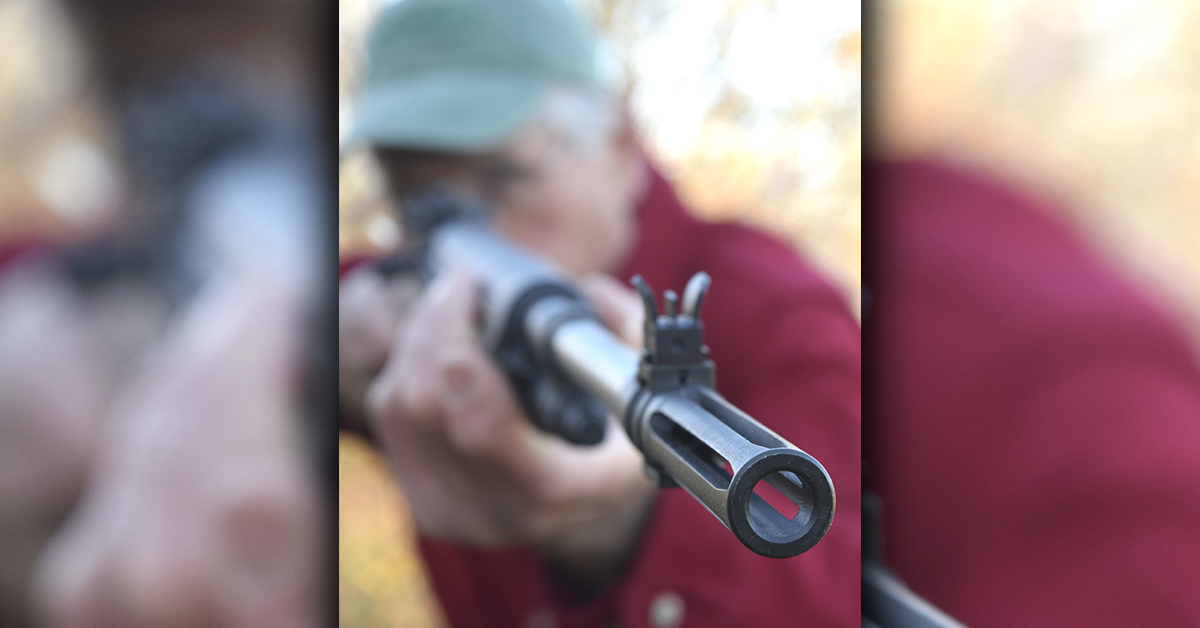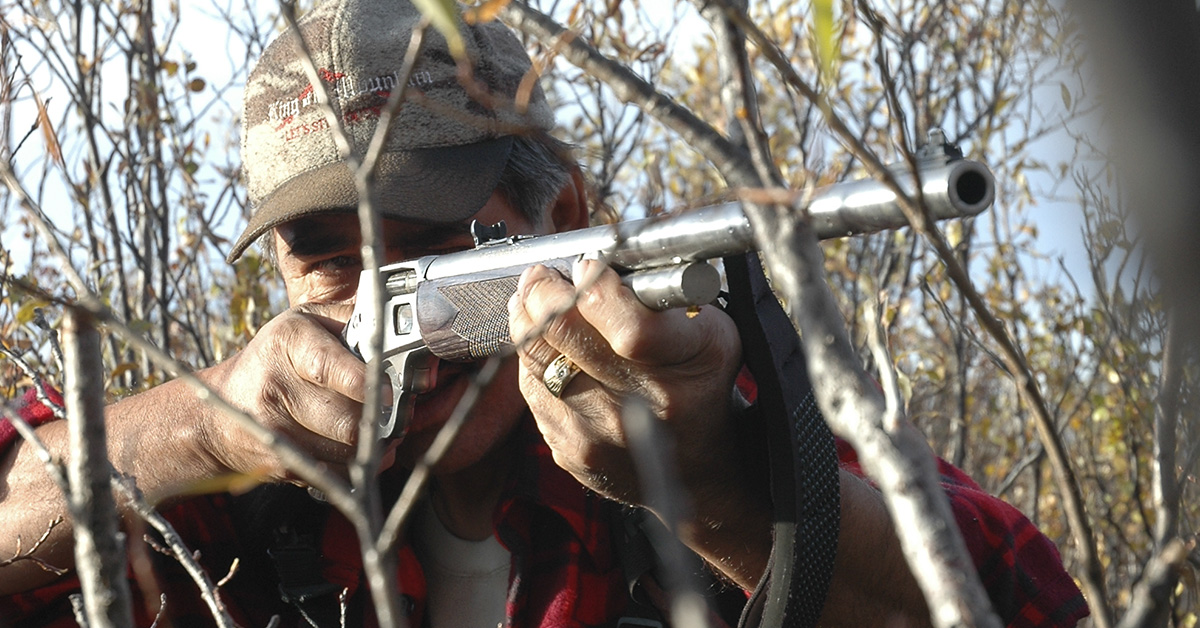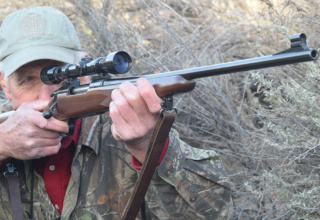Wobbly rifles can make good hits. But the odds are better when you control the wobble. Here’s how.
by Wayne van Zwoll
The day was nearly spent. Big prints in patchy snow had led me through a great, crenulated basin. Then, suddenly, there he was! But the wind, thundering in gusts from a bruise-black horizon, bounced my rifle. At 50 yards, the sight wouldn’t stay on rib. Snow from the descending blizzard curtained his thick mahogany antlers. I took my finger off the trigger. A second later, he was gone.
Why not drop prone? Or sit? First, his eyes were locked on me. Secondly, a basalt ledge between us blocked a low bullet path.
Why not try a shot standing? Because an errant bullet cripples before it strays far enough to miss.

Marksmanship is an acquired skill. If you come to you think yourself a “natural,” your targets are too big or too close. Those blessed with exceptional eye-hand coordination and ice-house physiques must still hone technique. Controlling the rifle as you aim is a brief task. On a hunt, none is more consequential.

Prone and sitting lower your center of gravity, which makes you steadier. Prone, you get almost full body contact with Mother Earth — a real blessing. The sit I use most afield is quick and well adapted to uneven ground: Knees up, plant your heels well apart and lean forward, bringing the backs of your elbows against the fronts of your knees, flat on flat. Your body becomes a tripod; back muscles hold it quite rigid.
Alas, the motion of dropping to prone or a sit from standing can send an animal off. It also burns seconds. Ground contour and brush can make low positions untenable.
You’ll get a shot faster standing — offhand — or going to one knee. These high positions do come with more wobble, so hunters with sensitive egos avoid using them in public. Indeed, at shooting ranges just before deer season, you’ll find everyone on benches printing groups to cover with a coin. How odd.
Kneeling
Kneeling is steadier than standing, as you have three points of ground contact. You’ll kneel faster and easier than you can get into a sit, and you’re better able to aim uphill. Kneeling lifts the sight-line above low grass and brush and affords you a limited swing to follow moving game. Kneeling keeps your torso upright, right arm free, so you can better run a bolt or lever.

Kneeling can find a bullet alley for you. Last year in foothill forest, I eased within 70 yards of an elk quartering off. But thick conifer boughs hid the ribs until I sank to one knee. The shot was easy; the elk didn’t know from whence it came.
A proper kneeling position dramatically reduces wobbles. In four-position matches, my kneeling scores often equaled my sitting. But I’ve seen hunters put the wrong knee up, others keep their bum in the air, others fail to rest their elbow.

If right-handed, kneel with your right knee on the ground. Keep your left knee up, shin vertical beneath it. Sit back on your right foot, tailbone on your heel. Half your weight should rest on the toes and balls of your right foot. Put another third of your weight on your front (left) foot. It supports the rifle, as the flat of your left elbow rests on the face of your left knee. The point of that elbow falls just forward of the knee, not on it! Stacking movable joints adds no stability. The right knee, which contacts the ground, bears only about 15 percent of your weight. It’s a brace, not a load-bearing leg of your tripod.

A solid kneeling position is upright, your back and neck nearly vertical, head erect, eyes looking straight through the sight. (If you slouch, weight comes off your tail-bone onto your left leg, which will collapse forward or tip.) Your left foot should point naturally toward the target.
First sessions kneeling are uncomfortable. Your right foot, curled under, complains. Give it some relief every few shots. Also, use a kneeling roll. Mine is an 8-inch-wide carpet strip just long enough that when rolled tightly and taped, it just fits under my right ankle. Of course, you won’t have a kneeling roll in the woods, but firing at game, you won’t feel your ankle, and seldom will you stay in position long.

Wobble from kneeling is mostly horizontal. Attack it this way: After dropping to your knee, take enough pressure off your left foot to turn it in, parallel with your right leg. Now re-establish proper weight distribution: 50 percent through your tailbone, 35 percent on your left vertical left shin.
“Wait!” you cry. “Shooting positions rely on bone support! Muscles must stay relaxed, lest they tire and quiver! Rotating the left foot in puts the calf and thigh muscles of that leg under tension!” You’re spot on. But after you turn that foot, you load the leg again, so the weight of the rifle and your body hold that foot flat. No muscle effort required. Calf and thigh muscles are locked in a slight twist. Their tension reduces the tendency of your left leg to swing, subduing 3-to-9 o’clock wobble.

Offhand
Offhand (in some circles “awfulhand”) removes one leg of the tripod your body became in sitting and kneeling. It raises your center of gravity. Wobbles are more violent and not as predictable in timing or direction as in lower positions. You can mitigate the chaos this way:
Place your feet shoulder-width apart, weight evenly distributed, with a tad more pressure on the balls of your feet than on your heels. The rifle must point naturally at the target, so align your stance to that end. An imaginary line across my toes intersects my line of sight at about a 30-degree angle. Placing your feet consistently in one short step is worth practicing. A slight, natural forward lean helps counter recoil. But beware overloading your front leg.

Pull the rifle firmly into your shoulder pocket. Hold your right elbow horizontal, the left nearly underneath the rifle. Bring the stock to your cheek; your face should drop or tilt very little to aim. Touch the trigger with the first joint of your index finger. As in all positions, keep both eyes open. A scope is best mounted to yield 3 ½ inches of eye relief when your face rests as far forward as is comfortable on the comb. Before cinching scope rings tight, throw the rifle to cheek fast, as you would shotgunning grouse. Many shooters sitting at a bench place scopes too far back for use in field positions. Besides banging your brow in recoil, (especially on uphill shots), a scope with too much rear overhang forces you to pull your face back to get a full field of view. That motion steals time and focus. Aiming a scoped rifle should come as naturally as pointing a shotgun and deliver a full scope field instantly.
Take two deep breaths, one as you bring the rifle up, the second as the sight settles. Relax as you exhale that one; don’t forcibly empty your lungs. The sight should hover comfortably about point of aim. Pressure the trigger when the sight is on target; hold pressure when it moves off. When you run out of air or if the rifle starts to shake badly, start over. Resist the urge to time a shot to your wobble, “catching a good hit on the fly.” You’ve a better chance of timing the stock market. A quick trigger pull disturbs the rifle before the bullet leaves.

Offhand shots are commonly assumed fast shots, taken when there’s no time for a steadier option. But often you’ll have plenty of time. Last year, on Namibia’s Caprivi Strip, I crept toward a Cape buffalo in grass so tall no other position was tenable. A few yards from the bull, a slot to his shoulder put me on the trigger. The uninitiated might think a buffalo a big target. Of course, my target was not the beast, but a small spot on its shoulder. I took very careful, deliberate aim. The 9.3×62 bullet hit spot on.
The Mental Game
“Center shots are made before they’re fired,” declared my first coach, Earl Wickman, “Beyond the mechanics of position, you must think a hit to make one. Missing is always an option, so don’t try to tell yourself it isn’t. But every shot can hit! And you control every shot.” He paused to tap ashes from a cigar thick as a breakfast burrito. “If you fear a miss, it’s because you’ve thought too much about it.”

Don’t delay a shot to analyze it or gild it. Sight pictures are short-lived, and even good ones are never still. Just release the bullet. The longer you aim, the more desperately you want to breathe again. Wobbles become shakes as your muscles tire under the rifle’s weight. Eye fatigue burns a target image into your brain. Offhand, your body starts to sway. Competitive shooters allowed a minute a shot may make several “runs” before taking the last ounce off the trigger, lowering the rifle to start over each time. That said, insisting on X-ring precision on a hunt is seldom practical. If the sight dances from the second to the fourth rib — well, a killing shot gets the prize.
When you’re buffeted by wind or gasping after a climb, even low positions won’t steady the rifle. The obvious solution: get out of the wind, let your pulse subside, find a steadier position. No time? You’ll have to fire or decline. I’ve yet to regret declining a shot; but pokes I’ve triggered that, for want of sound judgment or marksmanship, didn’t yield a quick kill have made me out a fool. These live long in memory.

You’re not finished when the bullet leaves. Whatever the position, follow through, cycling during recoil as you call your shot. Without changing position, bring the rifle back on target. If you didn’t see or hear the bullet strike, or if the animal is out of sight in a jump, you should still know where that shot went. An accurate call means you had your eyes on the target and knew where the sight was when recoil jerked it away. Calling shots well is evidence you’re on the path to controlling wobble.
Top Two Tips
Not all hunters agree as to the best gear and techniques for better field shooting. Here are my two:
A rifle always points somewhere. When it’s in hand, your position determines its natural point of aim — that is, where it wants to spend most of its time if you’re not forcing it to point elsewhere. Wobbles make perfect shots rare, but hits close to center are more likely if the rifle relaxes onto your point of aim. Tack a business card to your living room wall. Quickly get into a shooting position, the card your target. Aim. Close your eyes. Relax. Count to five. Open your eyes. Is the sight still on the card? If not, move your body to correct. Don’t muscle the rifle with your arms. After a few repetitions, you’ll know instantly how to orient your body so natural point of aim falls on the target.

A sling (a shooting sling with a loop independent of sling length, not a carrying strap) helps you steady your rifle prone, sitting, and kneeling. I’ve used Brownell’s Latigo Sling for 40 years and still find it the best. A one-time loop adjustment for your arm and shooting style suffices. Snugged around your left arm above the triceps, the loop comes taut to the front swivel. It’s loose from your arm to the rear swivel. Give the loop a half-turn out (so it will lie flat on your wrist), flip your arm over it, and grab the forend as you settle into position. Practiced, it’s one motion. The sling transfers the rifle’s weight from your wrist to your left shoulder, which better supports it. It tugs the buttstock into your right shoulder. And of course, a shooting sling doubles as a carrying strap. Bipods? They help in prone, but I find them slow to deploy in other positions, especially on uneven ground. They add bulk and weight to the rifle — and you’ll still need a strap for the carry!













